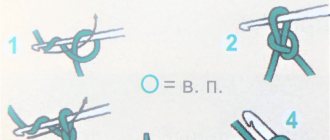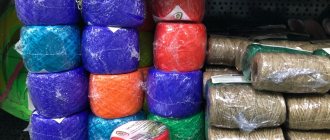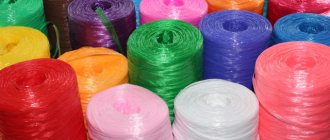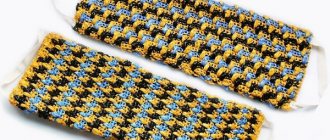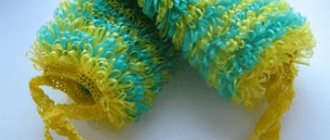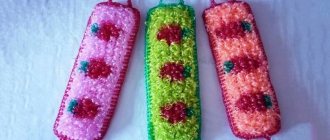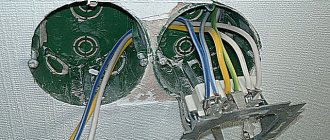A washcloth is one of the very important components that is necessary when taking a soothing bath or invigorating shower. With its help, we cleanse our body of dead skin flakes, refresh it, make it smooth and well-groomed. Of course, many of us buy this item in stores, but why not make it yourself. There are many ways you can perform this element of hygiene with your own hands. At first glance it may seem that this is not a simple task, but in fact everything is quite simple. We will learn how to make a washcloth using a hook. You can knit it in different shapes, and then fill it with other material and give it a large volume. In this case, you don’t need to spend a lot of time, but the craftswoman herself will be responsible for the quality of the work performed. A round washcloth can be crocheted in a short period of time, but even here you need to know how to knit, taking into account the pattern. A washcloth can be so interesting that you won’t even find one like it in stores. For example, many needlewomen like to make such products in the form of animal figures: turtles, hedgehogs, cats. This is especially true for young children who love everything unusual. And if you make the washcloth in a bright color, you can be sure that the child will be delighted with his new animal washcloth.
Such products can also serve as a gift for a loved one. This is especially suitable when you really want to do something nice, but the financial side is hampering you. Therefore, get ready to take the yarn that is left over from previous products and start knitting something interesting.
Crochet Basics
For those who have already mastered them, scroll on. For those just starting to figure it out, here are some tips:
Air loop
Double crochet
Single crochet
Connecting post
Follow the links and watch the step-by-step description with video
- How to learn to crochet
- Adding and decreasing stitches with crochet. Long loops
Which yarn to choose for knitting a washcloth
There are no exact instructions here. Although specialized threads exist. These are sold in stores, but they cost from 200 rubles.
If you want to knit a “purchased” option, then go to a fixed price, they sell twisted thread for only 50 rubles. One skein is enough to knit a washcloth.
True, there is a nuance here: a ready-made washcloth with elongated loops is sold right there, only 5 rubles more expensive. Buy or knit yourself - it's up to you.
- A polypropylene thread is ideal (the one mentioned above). It is hard and synthetic. Dries quickly.
- Wool. It's always nice to use natural materials. You can even buy untreated thread, which is a little prickly - a scrub effect.
- Twine or jute thread. Rough, it is used for bath sponges.
- Plush yarn. Soft, pleasant to the body. Foams well.
- Yarn-grass. It will give volume and be just as soft and tender.
- Cotton. The most versatile fiber.
Any leftover yarn with any composition. Don’t think that a washcloth can only be knitted from a special material. Absolutely any yarn that is available will do. Here it is important to understand what is right for you: whether you want to wash with a synthetic washcloth or prefer natural fibers. But there is no difference in knitting.
Which yarn won't work?
Mohair, angora - all “fluffy” threads. To knit a washcloth, it is better to take non-fluffy yarn that will not deform if it comes into frequent contact with water.
How to make a jute washcloth softer?
For me, a person of the principle “what I see, I sing,” words are very important! And the description of the product is exactly the same. My every word, spoken or written, is confirmed by action. And, if I wrote that my jute washcloth is “processed and ready for use, you just need to remove the packaging,” then this means that the washcloth is really processed with the frenzy of a terry perfectionist and is safe to use even internally (but it’s better not to, because it doesn’t tasty). And so I decided to show you the process of this most thorough processing:
2 photos - freshly knitted washcloths, hard, prickly, completely unsuitable for use (in my opinion)
3 photos - I soak and wash the washcloths by hand in a mixture of rather aggressive detergents (I prefer more or less natural ones). The water after this process is like that swamp slurry 4 photos - a thorough rinse. The water is already cleaner, but not quite yet 5 photos - washing washcloths with handmade soap and coconut oil. I wash, scrub, and rinse each washcloth separately. 6 photos - I steam it in very, very hot water (almost boiling water) for 20-30 minutes. Then I rinse it one last time.
7 photos - washcloths are dried in the sun in summer, in the cold in winter
8 photos - already pleasant to the touch, clean, fragrant washcloths are being preened - I sew on tags, loops, pack them, seal them in bags with instructions.
And now, in full bloom and in the best possible shape, the washcloths go on sale. By the way, the photo shows very clearly how the structure of the jute thread changes. Remember this difference well! This will help you distinguish between a treated and safe loofah and a dishonest and unkempt one.
Crochet washcloth with elongated loops
The most common knitting option. This model took one skein of yarn from the fixed price. There are different colors available.
Once you understand how elongated loops are knitted, you can knit any type of washcloth this way. That is, by applying the pattern you like and adding elongated loops to it.
A crocheted washcloth for beginners with elongated loops is a rectangular product with two handles (you can hang a washcloth on them, and you can use them to thoroughly wash your back). This is a classic that came to us from the Soviet Union. Probably every family member had one in every apartment.
You will need:
- Hook No. 2
- Skein of polypropylene thread, 300 m.
We cast on 40 air loops , close the knitting in a circle using a connecting loop.
We knit one row with single crochets.
Knitting with polypropylene thread will seem unusual at first. The yarn falls apart into fibers and does not obey. Therefore, take hook No. 2 - it fits perfectly.
Let's make the first handle of our washcloth. To do this, knit 70 vp from the first loop. and using a connecting loop, secure it on the opposite side of the washcloth (in the 20th st. b/n). We knit a row of single crochets in the opposite direction - to the first loop of the washcloth. This will be the handle.
Knit 4 more rows of single crochets.
Extended loops
Knitting is much easier than it seems. Initially, handicraft textbooks advise using a ruler:
I make such loops using my thumb - it’s easier and faster. Watch a video of knitting a washcloth with elongated loops:
Knit this way for a length of 20 centimeters. Want more? – Then buy two skeins of thread.
We knit in a spiral. That is, we do not make a connecting loop at the end of each row. We knit in a circle. For convenience, you can hang a marker on the first loop. Essentially, we finish knitting when the thread comes to an end.
At the end, knit 5 rows of single crochets.
Next: 70 vp, attach the tie to the opposite side and knit in the opposite direction. – the second handle of the washcloth.
Cut off the tip and secure it to the wrong side.
If you knit elongated loops as shown in the video, they will not stretch or get tangled. You will get a “purchased” option.
Video lesson:
Single layer washcloth
When knitting this washcloth, elongated loops are knitted on both sides. To obtain a more fluffy washcloth, knitting was carried out in two threads. That is, two skeins are used or one, then the second end is additionally pulled from the inside. After casting on an air row of loops, a row of stitches with one crochet is knitted.
The next row is knitted without double crochet. After the third row, we begin knitting with elongated loops, forming them with the thumb. In the last stitch of the row, a single crochet stitch is knitted. After turning the work over, the next row is knitted with similar elongated loops, and they end up on the opposite side of the product.
Crochet oval washcloth made of plush yarn
For those who like to take a bath with a lot of foam. This is a straight “cinematic” version of a crocheted washcloth.
The washcloth is oval, knitted according to the oval pattern:
We dial 11 v.p. and 3 more v.p. rise.
We knit 5 double crochets in the 4th loop from the hook.
And then 9 treble stitches in each next loop. In the last chain stitch of the row we knit 6 treble stitches.
Another 9 treble crochets in each loop (already on the second side of the oval). Finish the row with a connecting loop in the 3rd ch. rise (which was knitted at the beginning).
The knitted rows are hard to see in the photo, so take a look here , it tells you simply and step-by-step how to crochet an oval.
Our washcloth will require 6 rows according to the pattern.
Then knit two handles from ch. as shown in the photo.
If desired, you can knit two identical oval fabrics and sew them together - the washcloth will be denser.
Crochet washcloth mitten
We will knit two identical triangular fabrics, sew them together, leaving room for the thumb (we will tie it at the end).
We dial 40 v.p. + 2 v.p. rise.
12 rows - double crochets (straight and reverse rows). We start each row with 2 ch. rise.
Decreases
2 v.p. lifting, 1 st.s/n, skip 1 column. And symmetrically at the end make the same decrease: skip one column, 2 treble crochets.
Making such decreases by skipping two columns in each row (at the beginning and at the end) diagonally will be more beautiful.
That is, 2nd r. decreases: 2 ch. lifting, 2 treble s/n, skip one column. At the end of the row, the same decrease is symmetrical.
3 r.: 2 ch. lifting, 3 treble s/n, skip one column.
Knit in this way until the diagonals of the decreases converge into one column in the middle.
Next are two rows - double crochets.
Knit the second fabric for the washcloth in the same way.
Sew them together on both sides, leaving room for the thumb (try it on as it will be more convenient).
Along the perimeter of the hole, crochet single crochet stitches and knit 3 rows in the round. Then make one decrease in the same place in each row - just skip one single crochet until the finger is completely closed. Pull the remaining loops together with a needle and fasten to the wrong side.
Assembly
The washcloth mitten itself is quite spacious. We did this on purpose. Now let’s try it on our hand so that it doesn’t dangle, but also doesn’t put pressure.
We knit 6 rows around the perimeter of the washcloth using single crochets.
From the outside (depending on which hand you will put it on), turn it over and sew it on the front side (just make a couple with a stitch with a needle).
Tie a loop of chain stitches.
A crocheted washcloth mitten with elongated loops is knitted according to the same pattern, only instead of double crochets, knit single crochets with elongated loops.
How to knit a loop for a washcloth
Crocheted rectangular washcloth made of rope
Brutal men's option for a bath. Knitting is quite simple - double crochets alternate with an air loop.
At first it will be unusual to knit with such a thread, but soon you will get used to it.
Required:
- hook number 3
- rope or jute thread (sold in construction stores, fixed price, etc.)
Crochet washcloth video:
Dial 20 ch. + 2 v.p. rise.
3 v.p. rise + 1 v.p. + double crochet in every second ch. set.
Next row: 3 ch. rise + 1 v.p. and st.s/n in v.p. previous row.
Knit to the desired length. Moreover, you can use this rectangular washcloth both in this form and folded.
Attach the handle from v.p. at the end.
A washcloth crocheted from twine will be rough, but it will help against cellulite and improve blood circulation: the skin will immediately turn red. She needs to be led from the bottom up: from the heels to the torso. On the arms: from the hands to the shoulder, as if dispersing the blood in the opposite direction.
Helpful information
Before we start, let’s reveal some secrets of the craft:
- For knitting, you can use a variety of materials: polyester, cotton, jute, nylon, twine (propylene foam or other composition). Sometimes craftswomen even knit from nylon tights and plastic bags;
- The most commonly used material is polypropylene thread. Items knitted from twine have a brighter color, are wear-resistant, they are able to create a good foam and dry quickly enough. The optimal choice of hook is No. 3 or 4;
- The rigidity of the finished product directly depends on the thickness of the threads. For children, it is better to choose a softer washcloth;
- The chosen color of thread for the washcloth can match the color scheme of the bathroom;
- Before first use, keep the product in boiling water to make it softer;
- Adding foam rubber to the washcloth will improve the formation of foam; for this, the design must be in the form of a pipe.
Crochet square washcloth
The simplest knitting option. Take your favorite square pattern. Knit two identical fabrics, sew them together and make a hanger loop.
You can take a granny square .
Several layers of foam rubber or simple fabric are often placed inside for softness.
Crochet square patterns
Crochet round washcloth - shell
Knit two identical round fabrics, sew them and tie a loop. This is the simplest option.
Circle crochet patterns
Below you will see a master class on knitting a washcloth-shell. These are the same two canvases, but they are knitted with threads of different thicknesses, due to which a recess appears for the hand, and the washcloth itself resembles a shell.
We collect 6 vp, fasten them into a circle. 3 v.p. lifting and 15 treble s/n in this circle.
2nd row. 2 treble crochets in each double crochet of the previous row. At the end - a connecting loop in the 3rd ch. lifting (do this in each row).
3rd row. 3 v.p. lifting and 2 treble s/n in treble s/n of the previous row. Then twice, one treble s/n in each treble s/n before. row. We alternate until the end of the row according to the pattern.
4 row. 3 v.p. rise. One treble s/n in each treble s/n of the previous row 2 times. In the 3rd st.s/n - 2 st.s/n. That is, we knit 2 treble s/n in 2 treble s/n of the previous row, and in the next column - 2 treble s/n. and so on until the end of the row.
5 row. According to the drawing - all st.s/n
6th row as 3rd
7th row as 4th
Row 8 is like 5th.
For the second piece of washcloth (white, made of wool), knit it in exactly the same way. But this circle will be larger due to the fact that the thread is thicker.
We sew two motifs as shown in the video:
Finish with a loop-tie made of v.p.
Instructions for knitting different shapes
Crocheting is different in that in a short time it is possible to knit a variety of soft toys for children. Little fidgets love soft toys filled with synthetic padding.
We offer several options for knitting figures:
- Hedgehog. The work begins with making the tail. Cast on 15 loops and knit a chain, closing it in a circle. In the process of knitting, loops are pulled out in a circle. This method is used to knit strawberries, berries, and also the cartoon characters Smeshariki.
- Complex figures like a bunny or a dog are knitted similarly, however, from several parts. To complete the work, all parts are connected.
Making your own washcloth will help involve your child in the process. A girl or boy of 11 years old can work with crochet - the process is easy to explain and teach.
Voluminous double crochet washcloth
Everyone once had or has such a washcloth. This analogue is easy to knit with your own hands. The scheme is simple.
Let's take a hair elastic as a base.
This is not necessary; you can use a standard set of air loops.
We tie it with double crochets as shown in the video = 44 treble crochets
1 row. 2 treble s/n in each treble s/n of the previous row. = 88 st.s/n
We knit all subsequent rows in the same way: 2 double crochets in each column of the previous row. The photo shows a 7-row voluminous washcloth. You can knit more or less as you wish.
At the end, tie 50 vp. and attach the string to the washcloth.
A little history and purpose
It is not known for certain when the first devices appeared to help cleanse the skin, but already in references in Babylon and Ancient Greece there is information about the first washcloths. Wealthy people used wood or bronze to wash their skin, while poor people used bunches of plants or sand.
Now, a washcloth is already an absolutely necessary household item for every person. Beautifully designed, of different sizes, colors and purposes, they decorate the bathroom and are indispensable assistants in the bathroom.
A washcloth can be made from any available material: natural cotton or chintz, using old terry towels, woven from burlap, and for those who are not looking for easy ways - knitted.
Crochet washcloth for beginners
Naomi Adelia yarn was used for this model. It has a textured thread already knitted, so the washcloth will be dense and beautiful.
Using hook number 8, cast on 12 chain stitches.
3 v.p. instep and 12 double crochets in each chain stitch.
Unfold the knitting. Again 3 ch. rise and 12 treble s/n in each column of the previous row.
Knit 16 rows with double crochets in length.
Fold the washcloth in the middle and sew along the edges.
You can put soap inside. Make a loop from thread without knitting air loops.
DIY sponge nets for dishes
Sea sponges
We have prepared for you 2 options for homemade dish sponges made from vegetable mesh. The first option is the simplest, the second is more elegant. You can make such a thing in 5–10 minutes. It's also a useful craft idea that you can easily make with your child. Try it, you will definitely succeed!
You will need several nets for vegetables of different sizes.
- Make a neat cut on one side and remove the contents.
- Cut off the fixing brackets and stickers.
- If the mesh is small, we recommend taking several at once. Carefully roll 1-2 nets with the cuts inward and tie a smaller net in the center.
- Our “washcloth” is ready for use. You can improve it a little - fluff it around the edges, giving it the shape of a bow.
Loofah – ball with filler
Crocheting a washcloth can also be in the form of a ball. This is a very interesting option for those who love unusual and environmentally friendly things.
First we crochet the ball.
3 v.p. connect in a circle.
1 row. 1 v.p. rise (in each row) and 6 tbsp in this circle. Finish with a connecting loop in v.p. lifting (in each row).
2nd row. 2 st.b/n in each st.b/n of the previous row.
3rd row. St.b/n + 2 st.b/n. Alternate dc and 2 dc until the end of the row.
4 row. St.b/n, st.b/ + 2 st.b/n. Alternate according to the st.b/n, st.b/n + 2 tbsp.b/n
5 row. First, 3 times tbsp + 2 tbsp.
6th row. 4 times tbsp./n + 2 tbsp.b/n.
Knit in this way until you alternate 10 tbsp and 2 tbsp in the next stitch.
Then knit 20 rows according to the pattern, without adding single crochets. I changed the yarn in the middle of the wash ball.
Now let's make the ball smaller.
1 row. 10 tbsp, decrease (skip one tbsp).
2nd row. 9 st.b/n + decrease.
Knit this way, leaving a small hole for filling.
How to fill a bulky washcloth with a hook:
- Dry herbs. You can use mint, lavender, etc. Ideal for a bath.
- Hay. It will sting a little, but this has its own charm - the effect of a scrub for rough skin particles.
- Buckwheat husk. Massage effect and anti-cellulite prevention.
- Sintepon. Soft and voluminous. Suitable for those who love foam.
- cotton wool
On a note. A sponge ball with filler will take longer to dry than a regular one. Therefore, after use it is better to put it on the battery.
After this, tie the remaining rows of the ball, evenly distributing the filler. Make a loop.
Crochet baby washcloths
A knitted washcloth for a child should not only fulfill its main function, but also be interesting to the baby. To make the washing process a joy. For these purposes, needlewomen have come up with various patterns for knitting washcloths.
With a three-dimensional pattern
A do-it-yourself washcloth for children can be knitted according to a pattern. That is, you knit a simple fabric from single crochets, and on it you knit a fish, a duck, a bow or any other object with voluminous (lush/embossed) stitches.
Fish washcloth, knitting patterns
Knit one or two identical fabrics in the shape of a fish according to the pattern. You can use bright baby yarn. Do not decorate a baby washcloth with plastic eyes or other accessories to avoid scratches.
Children's washcloth toy
An interesting knitting option, but you need to think about how to fill it. You can use special granules that are sold in craft stores just for this purpose (filler for toys). They are made of plastic, will not get wet, and the washcloth will dry quickly.
There is enormous scope for creativity here: fish from the cartoon “The Little Mermaid”, yellow ducks, sharks, turtles, etc.
Soft or hard?
In the refrigerator and on the brush. Where do bacteria most often accumulate?
Bast washcloths are thin strips of bast that can be tied into a bun or sewn onto a fabric base. The bast itself is made from the inner bark of linden or other deciduous trees. Bast sponges are good for baths, but they are not recommended for use in ordinary bathrooms: the material crumbles and can clog the drain.
Suitable for: bast is a fairly hard material, so it can be used for deep cleansing of the skin. The washcloth can be softened a little by dipping it in boiling water for 10-15 minutes before use.
It is better not to use if you have delicate skin or if you prefer to shower with foam - the bast loofah does not foam well.
Loofah (sometimes spelled luffa) has recently become a popular material for bath accessories. It is a dried vine fruit that has been freed from the skin and seeds. Loofah can be found in the form of a roll, cut into pieces or “packed” in soap.
Who is it suitable for: the loofah is quite hard, so it can be used for peeling and anti-cellulite massage during water treatments.
It is better not to use for people with delicate skin and those who want to maintain a tan longer - a hard washcloth quickly erases the top layer of skin.
Linen washcloths are famous for their durability, ability to absorb water well and lather well. Items for water procedures can be knitted from linen threads or sewn from linen. In the second case, a piece of soap is sometimes placed inside the washcloth.
Suitable for: lovers of foam bathing and allergy sufferers.
It is better not to use for people with particularly delicate skin.
Sisal fiber is also used to weave washcloths, which are quite stiff, but have enviable strength.
Suitable for: those who want to get rid of dead skin on their elbows and heels.
It is better not to use if you have sensitive skin.
Bristle brushes of different sizes and different hardness are suitable for the whole body: with an accessory on a long handle you can scrub your back, small brushes will clean your fingers and feet.
Suitable for: Those who like a good back rub
It is better not to use for those with sensitive skin, or choose especially soft bristles.
Toys will help to accustom your child to water procedures.
For sensitive and problem skin, you should not choose hard washcloths made of sisal, jute, or coarsely knitted washcloths made of polypropylene tape. They will irritate the skin and provoke excessive secretion of sebum.
A washcloth as a gift
Once upon a time we were told that hygiene items should not be given as gifts. This applied to washing gel, shampoo, even perfume, etc. Now we come to the conclusion that any sign of attention is pleasant. Especially if you made it yourself.
It is important not just to knit a washcloth, but to pack it correctly and present it presentably. There are special labels and boxes for these purposes. You can simply attach a handmade paper tag (sold on Aliexpress, crafts fair), or you can order an individual design if you want to knit under your own brand. This packaging is quite inexpensive.
For example, such a paper label will cost only 8 rubles.
And this box costs 25 rubles. Search on Instagram, there are many accounts there that offer products to handicrafts.
Agree, + 33 rubles per skein of yarn that you will spend on knitting a washcloth is not such a cost. And the gift will look amazing.
In the kit with a knitted washcloth you can add handmade soap, eco-friendly bath products, aromatic oils, and a eucalyptus broom.
By showing your imagination, you can come up with different combinations. It is not necessary to give this gift for any occasion. For example, when going on a visit, please your friend in this way. Washcloths crocheted from white yarn look especially beautiful - a symbol of tenderness, purity and femininity.
With washcloths, as with toothbrushes, everyone likes their own firmness: some need it very soft, while others need it hard. As an option: knit a product from soft plush and hard rope for a bath. There will be a set for all occasions.
How to properly destroy a used amulet
The red thread is broken - what to do and how to deal with it correctly? Where to put a used amulet?
How to restore the Sponge — How to assemble Bath Sponge from a mesh / Life hacks
The enchanted red thread is the most famous and effective amulet that protects a person from adversity and disease. If you just started wearing a wrist amulet, and it already looks like it has been worn for a year, or even more, then first pay attention to the people who surround you. This is a sure sign that you encounter an ill-wisher every day.
When the pressing question arises of what to do with a torn red thread, magicians claim that without the appropriate ritual, its destruction can be very dangerous. During burning, all the negative energy that the amulet has absorbed is released. Prayer will protect you from this negative force. Each person reads a prayer or conspiracy, based on his religious beliefs. Christians can read the Our Father or the Virgin Mary about the salvation of sins.
